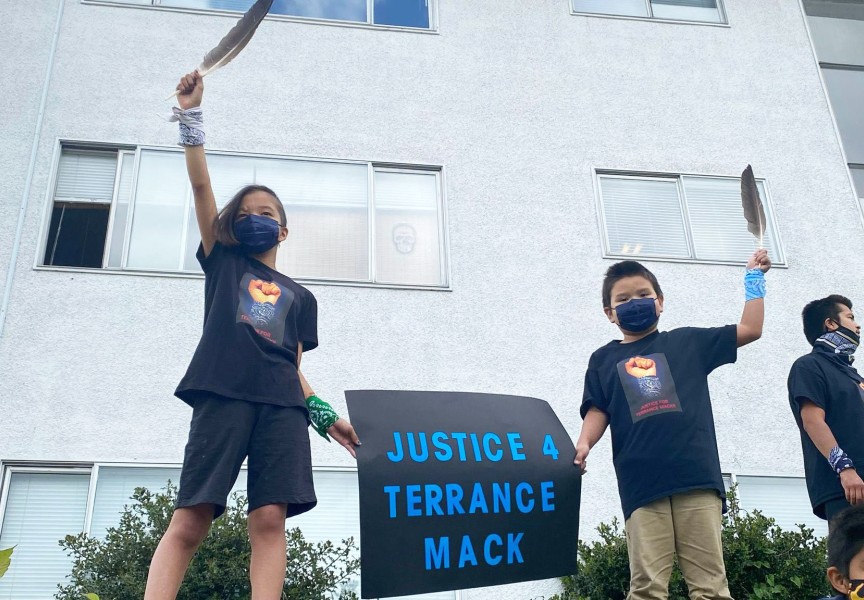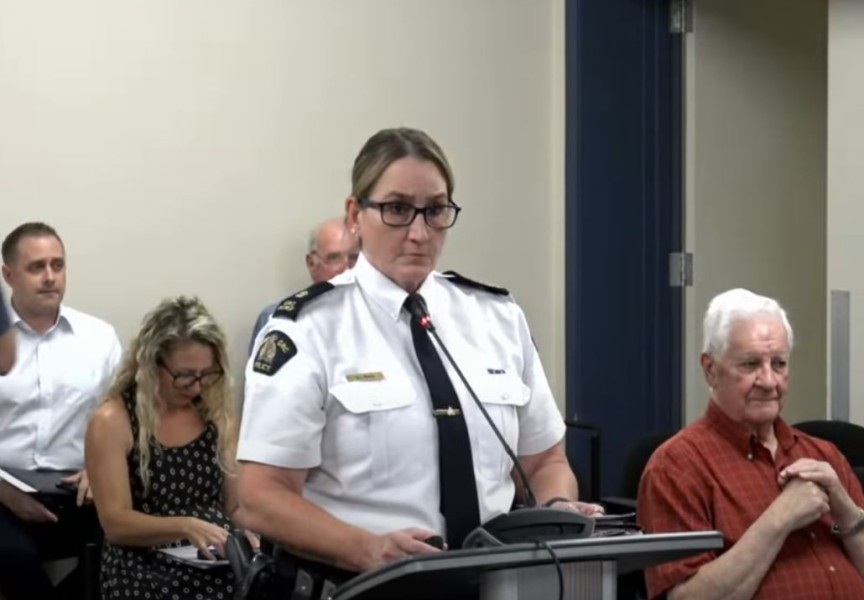After reviewing the BEI (Bureau des enquêtes indépendantes du Quebec) report on the investigation following the death of Chantel Moore, the New Brunswick Office of the Attorney General said they do not recommend any kind of homicide charges against Jeremy Son, the Edmundston Police Force officer that shot and killed Chantel on June 4, 2020, during a wellness check.
“My conclusion is that the situation was an emergency, that the officer had to react quickly in order to protect himself and he did not have any other option but to discharge his firearm in order to do so,” wrote the public prosecutor’s service in a legal opinion report, dated June 7, 2021.
The author of the report concluded that, although “deeply regrettable”, Chantel Moore’s death was the result of her being severely intoxicated by alcohol, “and combined with her actions, specifically exiting her residence brandishing a knife, steadily advancing upon Officer 1.”
But questions raised about whether or not Moore was brandishing a knife that night were not sufficiently answered in the available reports. There are inconsistencies about partial fingerprints found on the knife, which hand Moore allegedly used to threaten the officer with the knife, as well as when and where the knife was ultimately found.
Instead, investigators pointed to Moore’s intoxication and her possibly being depressed. They pointed to her previous suicide attempts, even though many of the friends and witnesses described her as happy that night.
The report includes a summary of events that lead up to the shooting death of the 26-year-old Tla-o-qui-aht woman. It contains never-before-released details that were included in the BEI report which was submitted to the Public Prosecution Services on Dec. 18, 2020.
The author of the legal opinion report stated that two significant items were missing from the BEI document - namely the final autopsy, which includes toxicology information and a forensic analysis of Moore’s cellular phone. A request for those items was sent in February 2021 and were received in late March.
Members of the Edmundston Police Force do not wear body cameras, however, they have videorecorders on their dashboards. In the early morning hours of June 4, 2020, their dash cameras were recording events near Moore’s apartment. While the cameras were not pointed towards Moore’s apartment door, they picked up sound and, coupled with witness testimony, business surveillance cameras in the area and phone analysis, the BEI were able to piece together a timeline for Chantel Moores’ final hours.
A series of text messages
Moore, a mother of a six-year-old girl Gracie, had recently moved to Edmundston after living in British Columbia for many years. According to her family, she had hopes and dreams. She had planned to go back to school, she worked at Boston Pizza, and she hoped to raise little Gracie, who was living with her grandmother Martha Martin in Edmundston.
On the evening of June 3, 2020, Moore was picked up from work at 7 p.m. by her friend and an acquaintance. The three young women planned to hang out and have some drinks. According to witnesses living near Moore’s apartment, the women were having a great time on the third-floor deck, drinking, talking to other friends on their phones and laughing loudly.
The acquaintance went home at 8 p.m. while Moore and her friend continued to socialize. They moved indoors when a neighbor complained about the noise. The neighbor described Moore as friendly and apologetic when asked to tone it down.
Shortly after midnight on June 4, a series of text messages were exchanged between Moore and her ex-boyfriend, who had returned to Quebec when the pandemic started. The two remained on friendly terms.
The messages from Moore’s phone to the ex-boyfriend started to sound like they were coming from another person, and they become threatening in nature. Investigators suggest that Moore may have been trying to manipulate her ex into reconciling.
The text message exchange continued from about midnight to 12:55 a.m. before the concerned ex contacted police to check on her. He had been working that night, during the time the texts were made.
During the text message exchange, Moore was caught on business surveillance camera walking her friend to her car at 12:39 a.m. and then going out to meet her again, when the friend returned at 12:59 a.m. to retrieve her wallet.
At 1:09 a.m. Moore attempted to video chat with her ex-boyfriend in Quebec, but the connection wasn’t made.
Four shots fired
An hour later, Officer Jeremy Son received information about a 911 call where the ex-boyfriend, concerned for Moore’s safety, asked for a wellness check.
Son told BEI investigators on June 6, 2020, that he was, in fact, the Use of Force instructor for the Edmundston City Police and had been for two years. Besides his sidearm, he carried pepper spray and a telescopic baton. He did not have a taser.
The entrances to the apartments where Moore lived were poorly lit and Son used his flashlight to climb the three-story set of wooden stairs. He stated that he could see a television set was on, illuminating someone sleeping on the couch directly below a window. He knocked on the window repeatedly in an attempt to rouse her. Instead, he woke a neighbor, who came out to see what was going on.
By that time, another officer arrived and, from his patrol car, could hear Son say in French that he woke her.
According to Son, Moore sat up; he said she looked confused. He said he used his flashlight to light himself up and pointed to the door to get her to open it.
“As he moved towards the entrance door, he saw through that door window that Ms. Moore retrieved something from the kitchen,” said the legal opinion report.
He said he could not tell what the object was but saw that it was something metallic.
“He said that she approached the door in an aggressive manner,” adding that he was already backing up as she opened the front door, said the report.
According to Officer Son, “she appeared angry with a furrowed brow.” He goes to say that he backed up from the door and removed his sidearm from its holster.
“Ms. Moore opened the door and came out of the apartment moving in his direction, with a knife in her left hand,” stated the report.
Rather than moving back towards the stairs, where he could have escaped, Son said he moved to the left of the front door and was backed up against the railings of the balcony, three stories up. He said Moore was holding the knife high, in front of her with the blade facing up and in his direction. He said she didn’t say a word but walked toward him at a steady pace with a blank stare.
Son said he ordered her, in French, to drop the knife repeatedly. Within seconds, he was backed up against the railings and “scared that she would hurt or kill him”.
“He fired four shots before Ms. Moore fell to the floor of the balcony and she released the knife,” the report stated.
Right-handed fingerprints on the knife
The report contains testimony from three other police officers that were on scene, at least two EMT’s that responded. While most of them saw the four shell casings, none reported seeing the knife. Witnesses living nearby report seeing several officers appearing to search the ground and staircase with their flashlights immediately after the shooting.
Eventually, a steak knife along with some pieces of Moore’s jewelry were recovered under a flattened cardboard box to the right of Moore’s body.
One witness who went outside after he heard the shots observed police officers searching the balcony, “side to side” with their flashlights. He told BEI investigators that he saw police move Moore’s body “end for end”.
“According to him, he believed the police added/placed the knife at the scene,” said the legal opinion report.
A forensic examination of the steak knife seized from the balcony revealed that the blade was 115 millimetres long (4.5 inches). Chemical treatment of the knife revealed the prints of three digits on the handle. While the ridge detail was not sufficient to identify a specific individual that held it, the forensic officer was able to determine that the prints indicate that the knife was held in someone’s right hand.
The crown prosecutor’s office dismissed the claim that the knife was planted, stating that one police officer and one civilian witness heard Officer Son yell, “drop the knife” in French.
As for the forensic analysis of the right-handed prints on the knife handle, the Crown prosecutor said, “there is no way to date the deposit of the prints upon this knife. This evidence, while considered, does not cause this author to conclude that the knife was not handled by Ms. Moore on the morning of June 4, 2021 (sic) nor that it could have been handled by Ms. Moore in a manner other than described by Officer 1 (Son).”
The author goes on to say that the knife was found by two forensic officers after the scene was secured. There is no information in the report about how much time elapsed between the shooting and when the scene was secured.
“I do not conclude that the knife was intentionally moved or placed by anyone, rather it may have been moved unintentionally, post-shots fired, possibly as Ms. Moore was turned over and attempts were made to apply pressure to her wounds,” wrote the author.
The autopsy report revealed that Chantel Moore suffered three gunshot wounds to the chest and one to her lower leg. The toxicology reported indicated that Moore was intoxicated by alcohol.
The Crown Prosecutor’s Office concluded that this was an emergency situation and use of force was not disproportionate with the threat.
“Since I have arrived at this determination, I am of the opinion that a trier of facts, properly instructed in the law, would be more likely to acquit Officer 1 (Son) of homicide than to convict him as such,” they wrote.
Angry but not surprised
But friends and family of Chantel Moore are bitterly disappointed at the decision.
“I’m angry but I’m not even surprised,” said Martha Martin after the decision was announced. “Us Indigenous people never get justice…would things be different if she were white?”
Son stated that it was only a matter of seconds from the time that Moore opened her door to the time he shot her.
When asked by investigators why he went to his left as Ms. Moore exited the apartment, he expressed regret for making that decision. As a Use of Force Instructor, he stated he knew that an officer should always take into consideration his environment, to ensure that they leave themselves an exit path. Had he followed his training and moved toward the exit route, he admits there may have been a different outcome.
“Canada need comprehensive police reform,” said MP Gord Johns. “Police are supposed to serve and protect people from all communities. The federal government must act to address the disproportionate violence Indigenous people face at the hands of police.”
He vowed to continue to advocate in parliament for Indigenous participation in investigations into police violence, ongoing mental health assessments of officers, enhanced vetting of new recruits and cross-cultural training for police forces at all levels of Canadian society.







